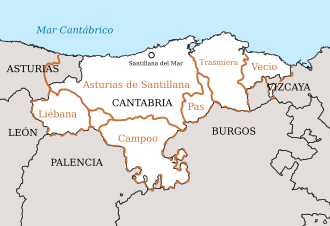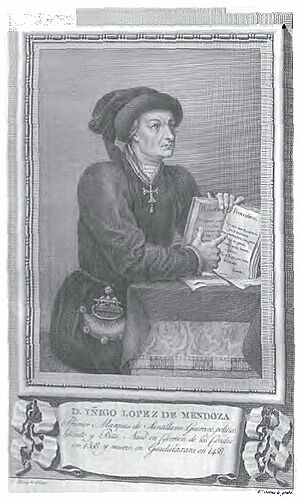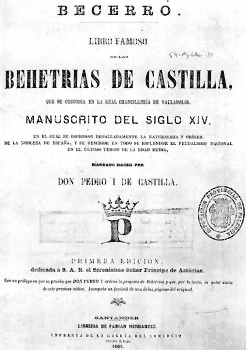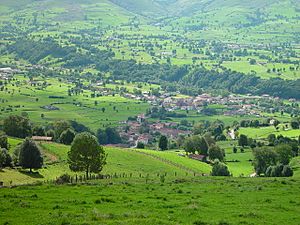Nine Valleys lawsuit facts for kids
Quick facts for kids Part of History of Camtabria |
|

Map of the merindades that existed in the territory of present-day Cantabria. The Nine Valleys were integrated in that of Santillana.
|
|
| Native name | Pleito de los Nueve Valles |
|---|---|
| English name | Nine Valleys lawsuit |
| Duration | 1544 - 1581 |
| Location | Santillana del Mar, Spain |
| Type | Lawsuit |
| Cause | Designation of Íñigo López de Mendoza as lord of the valleys and the claim of his realengo by the valleys themselves |
| Organized by | Chancellery of Valladolid |
| Participants | Asturias de Santillana Valleys against the Dukedom of the Infantado |
The Nine Valleys lawsuit (in Spanish: Pleito de los nueve Valles) was a long legal battle. It happened between the people of the Nine Valleys in a region called Asturias de Santillana (which is now Cantabria, Spain) and a powerful noble family, the Dukes of the Infantado.
This important lawsuit started in 1544 and ended in 1581. The Nine Valleys won! This victory was super important for how Cantabria became a region. It helped the valleys become independent. In 1589, they formed the Province of the Nine Valleys. This province later became the base for the Province of Cantabria in 1778. The lawsuit also weakened the power of noble lords in the area. The official record of this lawsuit is 178 pages long!
The Asturias de Santillana region was made up of many valleys. Even though feudalism was common, people in these valleys worked together. Each valley had its own local government and rules. When people fought against the nobles, they did it as a group, representing their whole valley. This lawsuit wasn't the only one of its kind. Other areas in Cantabria, like Liébana, also tried to break free from noble rule.
History of the Lawsuit
How it All Started
During the Late Middle Ages, the area we now call Cantabria was split into merindades. These were administrative areas of the kingdom of Castile. They were managed by an official called a merino. Different parts of these areas had different kinds of owners:
- Royal land (realengo): Owned by the King of Castile.
- Church land (abadengo): Owned by an abbot (a church leader).
- Noble land (solariegas): Owned by a nobleman.
- Crown land with a chosen noble (behetría): Owned by the King, but the people could choose a nobleman to pay taxes to.
From the 12th and 13th centuries, powerful noble families started to take over this region. They took power from the abbots, who had held special rights since the 9th century. The nobles kept gaining more land and power, sometimes from the King, sometimes by just taking it. This meant they controlled more taxes, authority, and justice.
At the same time, the rights of the farmers and common people got smaller. They used to be able to choose their lords. The valleys of Asturias de Santillana used to hold big meetings before the first Duke of Infantado took over. The first meeting recorded was in 1430 in Santillana.
Documents like the Becerro de Behetrías (from 1351) and the Apeo of 1404 show how noble power grew. The older document shows more royal land and behetría land. The newer one shows much more land controlled by nobles.
One very important noble in the 14th century was Garci Lasso de la Vega I. He was a favorite of Alfonso XI of Castile. He was also a top official in Valladolid. He led the House de La Vega family and gained land in Asturias de Santillana. In the 15th century, the De la Vega family even challenged the King's power. They created a system called mayordomazgo to control more land. In 1341, King Alfonso XI gave the De la Vega family the valleys of Carriedo, Villaescusa, Cayón, Camargo, and Cabezón.
Later, Leonor de la Vega, who inherited the De la Vega family's lands, married Diego Hurtado de Mendoza. This created the powerful House de la Vega-Mendoza. Their first son, Íñigo López de Mendoza, inherited the Asturias de Santillana lands after his mother died. In 1445, King John II of Castile confirmed his ownership. But the valleys did not agree with this.
Even though the De la Vega-Mendoza family was the strongest, other noble families also fought for control. For example, the Counts of Castañeda took some areas in the valley of Camargo by force.
By the early 1500s, people in the Duke of Infantado's lands, especially in Asturias de Santillana, faced constantly rising taxes. They were very unhappy. They wanted to be free from noble rule because taxes would be much lower if they were under the King. Some communities, like those in Trasmiera, Soba, Ruesga, and Carriedo, had already seen their taxes drop after the Duke of Infantado lost power in 1505. They also didn't have to pay taxes on basic goods. However, after the Nine Valleys won their lawsuit and returned to royal rule, taxes actually went up even more!
The First Lawsuits
Many people think the Valleys lawsuit lasted from 1438 until 1581, or even until 1589. That's about 150 years! But it was actually a series of lawsuits. The first one was called the "Old Valleys Lawsuit." In that one, the nobles won.
The Old Valleys Lawsuit (1438-1444)
Around the early 1400s, the farmers in the Merindad of Asturias de Santillana were tired of their situation. They started several lawsuits against the powerful De la Vega-Mendoza family. The Old Valleys Lawsuit began in 1438. The valleys argued that they didn't truly belong to Íñigo López de Mendoza. They said they had only allowed the De la Vega family to rule because they thought the King hadn't heard their complaints. They also said that Leonor de la Vega had been a "true lady" and kept things calm.
But Íñigo entered the valleys with great force, taking control with his army. This made the peasants very angry and caused them to rebel.
In 1444, the first lawsuit was decided by the corregidor (a royal official) of Asturias de Oviedo. He ruled in favor of Íñigo López de Mendoza. Soon after, Íñigo got the titles of Marquis of Santillana and Count of Real de Manzanares. This meant Santillana del Mar was given to him. So, its merindad (administrative area) and general meetings ended. The De la Vega-Mendoza family now controlled the Asturias de Santillana. King Juan II confirmed this in 1448.
The marquisate included many valleys: Carriedo (which later split off), Cayón, Penagos, Villaescusa, Piélagos, Camargo, Reocín, Cabezón, Cabuérniga, Alfoz de Lloredo (all of which later split after the Nine Valleys lawsuit), Anieva, Cieza, and Lamasón. It also included the town of Santillana, the lands called Tierra de la Vega, and Pando (now Torrelavega). In 1475, the Marquis of Santillana also became the Duke of the Infantado.
The Carriedo Lawsuit (1495-1499)
Leonor de la Vega had left the valley of Carriedo to Íñigo López de Mendoza in her will. But this valley wasn't truly hers. In 1403, a conflict about its ownership had been settled.
However, in 1495, the farmers of Carriedo wanted to become independent. They asked the King for help in what became known as the Carriedo lawsuit. Carriedo was in the southeast of Asturias de Santillana. It belonged to the Velasco family but the Mendozas wanted it. The peasants didn't want to fall under the lords' control, who used violence to try and stop them.
The lawsuit was decided by the Chancellery of Valladolid (a high court) in 1499. The valley won! It gained its independence. The nobles appealed the decision, but it was confirmed again in 1504, 1505, and 1546.
In the Carriedo lawsuit, the valley said they hadn't complained earlier because "there was always favour and wars and fears." Like Carriedo, the other valleys in Asturias de Santillana later said they had never thought noble rule was fair.
The Nine Valleys Lawsuit
After the Carriedo valley won its lawsuit, other valleys decided to fight too. These were Alfoz de Lloredo, Cabezón, Cabuérniga, Camargo, Cayón, Penagos, Piélagos, Reocín and Villaescusa. They were all part of the Asturias de Santillana and belonged to the Dukes of Infantado.
The valleys presented their complaint to the Duke of Infantado in 1544. Reocín and Cabuérniga were newer possessions of the Duke. Cabuérniga joined the lawsuit later. The valleys told the King:
... the Councils and neighbors of the valleys of Camargo, Alfóz de Lloredo, Villaescusa, Cayón, Penagos, Piélagos, Cabezón and Riocín, declare that all the said valleys... are royal and of the royal crown of your kingdoms... And thus they could not and cannot separate... from the said royal crown, free and exempt from all vassalage, nor any manorialism, not being vassals of the said duke... The said duke by force and not duly, has entered and occupied against all reason and justice the said valleys...
First Decision (1553)
The first decision, on October 17, 1553, was good news for the valleys. They made progress on taxes and payments to the dukes. The court also said that the power to judge civil and criminal cases in their land belonged to the King, not the Duke. This decision was made because the court found that the Mendozas had forced their power on the valleys. They had given gifts to older relatives in the valleys to make them convince others to accept the Duke as their lord.
This decision did not accept the documents Íñigo López de Mendoza presented about his inheritance. The prosecutor even thought that more than fifty witnesses who spoke for the Duke had lied under oath. The Duke tried to appeal the decision four times.
Second Decision (1568)
The dukes appealed the decision, but in 1568, the court confirmed the earlier ruling.
Third Decision (1578)
In 1578, the Chancellery of Valladolid again confirmed that the local mayors of the valleys should have civil and criminal power. The valleys of Reocín and Cabuérniga, which had not been under noble rule until 1544, were also included in this decision.
Final Decision (1581)
In 1581, the court confirmed for the last time that the valleys belonged to the King. It was also decided that a new province, including these valleys, would be created.
Province of the Nine Valleys
The lawsuit's outcome meant the valleys returned to the King's control. In 1589, they formed the "Province of the Nine Valleys of the Asturias de Santillana." This brought back the King's power and reduced the nobles' power in the area. The new province was formed at the Casa de juntas de Puente San Miguel. In 1778, it was decided to join this province with others to form the larger Province of Cantabria. Even though that province didn't last long, it's seen as the start of today's Cantabria region.
The Province of the Nine Valleys received special rights from different kings. For example, Philip IV (in 1630) allowed them to be governed by "ordinary mayors." Because of this, 1630 is often seen as the year the province was created. Other times, people use 1581, the year the lawsuit ended. In 1645, the province's general rules came into effect, and they were updated in 1757.
Why They Fought
The Valleys' Side
The Nine Valleys used the Carriedo lawsuit as an example. Their main arguments were:
- Fairness: The dukes didn't let them choose their own mayors or judges. This meant they always had to go to Santillana del Mar for justice, which the dukes controlled.
- Safety: The roads between towns were not safe. Travelers going to Santillana were often robbed or even killed. This danger increased during the lawsuits.
- Money: The dukes forced farmers to pay taxes for justice, which the farmers felt was unfair. The dukes also put council representatives in prison if they protested.
- Corruption: The dukes paid scribes (people who wrote documents) to work for them. Also, the dukes' soldiers didn't stop violence or even murder, especially during the lawsuits. This caused more killings.
The Dukes' Side
The Dukes of Infantado argued that:
- Rights: They claimed the lands had belonged to the House de la Vega for 100 years. They also said that in 1420, John II of Castile had confirmed Leonor de la Vega's ownership of the valleys. However, this ownership wasn't actually enforced until 1448, and then it was done by force.
What Happened Next
The King's Reaction
The King was happy to get back power in northern Iberian Peninsula, which had been lost for three centuries. Besides creating the Province of the Nine Valleys, the valley of Carriedo, which had won its lawsuit earlier, received the special title of "Royal Valley of Carriedo" from the King.
The Dukes' Reaction

The dukes reacted very violently. Many people reported terrible things done by Íñigo López de Mendoza, his friends, and followers during the lawsuits. Juan Martínez, a witness, said the duke entered his valley with men, flags, drums, and trumpets. He forced the valley to surrender, making people and animals flee to the mountains. Then, he burned houses and punished anyone he found. Pero Díaz and Juan de Matamorosa, who opposed the duke, had their houses burned and were thrown out of windows. Don Íñigo even mistreated noble opponents related to the House de La Vega and imprisoned one for eight months. When the Infantado family finally lost the lawsuit in 1581, the duke at the time decided to focus on his lands in other parts of Spain.
The Lawsuit Document
The official document of the lawsuit, printed in 1566, is called Memorial contra las escrituras que el fiscal y valles presentan por autos de jurisdicción. This means "Memorial against the deeds filed by the prosecutor and valleys for writs of jurisdiction." It includes documents from earlier lawsuits against the same noble family, some from as far back as 1398.
The original documents of the lawsuit were lost for a long time. But on February 8, 1957, a journalist named Antonio Bartolomé Suárez found them in a house in Reocín! A family had been keeping them safe. In 2016, Antonio's son, Manuel Bartolomé García, was honored for his writing and help in telling the history of the Nine Valleys. He was named Escribano de la Merindad de las Asturias de Santillana.
The entire lawsuit document, called the memorial, has many extra papers and details. It gives a great look at what life was like in La Marina (a coastal area) from the early 1300s. It even includes a document called the Apeo de Pero Alfonso de Escalante.
Fortified Places in the Valleys
The lawsuit memorial is important because it lists the towers and fortresses in eight of the valleys (not including Carriedo). There were 43 towers and 2 fortresses, plus the Castle of Pedraja. That's a lot of strongholds for such a small area! People believe that in the 16th century, the whole Asturias de Santillana region had over 200 towers and fortresses. It also had more than 1000 plots of land owned by hidalgos (lower nobility), as mentioned in the memorial. The table below shows some of these towers and the noble families possibly linked to them, based on studies by Fernando José de Velasco y Ceballos.
| Valley | Towers and families |
|---|---|
| Villaescusa | Liaño tower (Liaño); La Concha tower (de la Concha); Obregón tower (Obregón); Villanueva tower (Ceballos). |
| Cayón-Penagos | Totero tower; La Penilla tower; Tahulú tower (Ceballos Escalante). |
| Camargo | Estaños tower; Maliaño tower (Herrera); Orozco family tower in Escobedo (Escobedo); four towers in Igollo (Portas [Disputed]); Herrera tower (Herrera). |
| Piélagos | Cianca tower (Ceballos); two towers in Quijano (Quijano); Renedo tower (Ceballos [Disputed]); Zurita tower (Ceballos); Rueda fortress (Ceballos, later Sánchez de Tagle); three towers in Oruña, Arce tower (Ceballos Escalante); Liencres castle (House de la Vega). |
| Cabuérniga | Sancho de los Ríos tower; tower in Terán (Terán); Valle tower (Díaz Cossío [Disputed]); Ucieda tower (Terán [Disputed]); tower in Sopeña (Díaz de Cossío), tower in Ruente (Mier y Terán). |
| Alfoz de Lloredo | Comillas fortress (House de la Vega); Ruiseñada tower (Bracho); Udías tower (Ceballos); Cubillas tower (Villegas [Disputed]), tower in Trasierra (Villegas); tower in Castro (Villegas); tower in Nuño (Villegas). |
| Reocín | Quijas tower (Bustamante); tower in Quijas (Calderón); tower in Ibio (Guerra); tower in Cabezón de la Sal (House de la Vega); tower in Cos (House de la Vega); tower in Santibáñez (Gayón); tower next to the Agüera river (Agüeros, after the Peredo family). |
See also
 In Spanish: Pleito de los Nueve Valles para niños
In Spanish: Pleito de los Nueve Valles para niños
- Cantabria
- Defensive towers of Cantabria
- Asturias de Santillana



